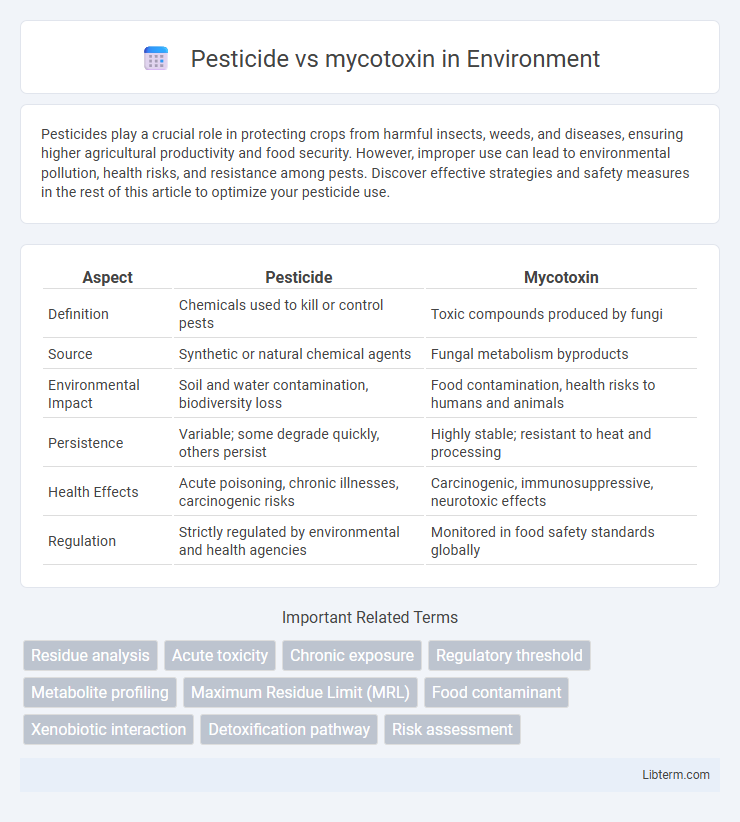Pesticides play a crucial role in protecting crops from harmful insects, weeds, and diseases, ensuring higher agricultural productivity and food security. However, improper use can lead to environmental pollution, health risks, and resistance among pests. Discover effective strategies and safety measures in the rest of this article to optimize your pesticide use.
Table of Comparison
| Aspect | Pesticide | Mycotoxin |
|---|---|---|
| Definition | Chemicals used to kill or control pests | Toxic compounds produced by fungi |
| Source | Synthetic or natural chemical agents | Fungal metabolism byproducts |
| Environmental Impact | Soil and water contamination, biodiversity loss | Food contamination, health risks to humans and animals |
| Persistence | Variable; some degrade quickly, others persist | Highly stable; resistant to heat and processing |
| Health Effects | Acute poisoning, chronic illnesses, carcinogenic risks | Carcinogenic, immunosuppressive, neurotoxic effects |
| Regulation | Strictly regulated by environmental and health agencies | Monitored in food safety standards globally |
Introduction to Pesticides and Mycotoxins
Pesticides are chemical substances used to prevent, destroy, or control pests that threaten agricultural productivity, protecting crops from insects, weeds, and fungi. Mycotoxins are toxic secondary metabolites produced by certain molds that contaminate food and feed, posing serious health risks to humans and animals. Understanding the differences between pesticides and mycotoxins is crucial for managing food safety and ensuring agricultural sustainability.
Definitions and Key Differences
Pesticides are chemical substances used to prevent, destroy, or control pests including insects, weeds, and fungi, whereas mycotoxins are toxic compounds produced naturally by certain types of fungi found on crops and food products. Pesticides are applied intentionally to protect crops and increase agricultural productivity, while mycotoxins occur as unwanted contaminants that pose health risks to humans and animals. Key differences lie in their origin, with pesticides being synthetic or natural chemicals used as treatments, and mycotoxins being biologically produced fungal metabolites.
Sources of Pesticide Contamination
Pesticide contamination primarily originates from agricultural practices involving herbicides, insecticides, and fungicides applied to crops to control pests and diseases. Runoff from treated fields, spray drift, and improper application contribute to pesticide residues in soil, water, and food products. Industrial discharge and improper disposal of pesticide containers also serve as critical sources of environmental contamination.
Origins and Types of Mycotoxins
Pesticides are synthetic chemicals used to control pests in agriculture, whereas mycotoxins are toxic compounds produced naturally by certain molds, mainly from the genera Aspergillus, Fusarium, and Penicillium. Major types of mycotoxins include aflatoxins, ochratoxins, fumonisins, and trichothecenes, each varying in chemical structure and toxicity. Unlike pesticides, mycotoxins contaminate crops post-harvest or during storage under warm, humid conditions, posing significant food safety risks.
Health Risks Associated with Pesticides
Pesticides pose significant health risks including neurotoxicity, hormone disruption, and increased cancer incidence due to their chemical residues in food and the environment. Chronic exposure to pesticides is linked with respiratory problems, reproductive issues, and developmental disorders, especially in agricultural workers and vulnerable populations. Unlike mycotoxins, which are naturally occurring fungal toxins primarily affecting the liver and immune system, pesticides are synthetic compounds with a broader range of toxic effects on human health.
Mycotoxins: Health Hazards and Impact
Mycotoxins, toxic secondary metabolites produced by fungi such as Aspergillus, Fusarium, and Penicillium species, pose significant health hazards including acute poisoning, immune deficiency, and carcinogenic effects. These contaminants frequently occur in staple crops like maize, peanuts, and cereals, leading to chronic exposure that compromises food safety and public health worldwide. Unlike pesticides, which are synthetic chemicals applied externally, mycotoxins are naturally occurring toxins that persist through food processing and require stringent monitoring and control measures to mitigate their impact.
Detection Methods for Pesticides and Mycotoxins
Detection methods for pesticides primarily involve chromatographic techniques such as gas chromatography (GC) and liquid chromatography (LC) coupled with mass spectrometry (MS), enabling precise identification and quantification of chemical residues in food and environmental samples. Mycotoxin detection commonly relies on enzyme-linked immunosorbent assays (ELISA), high-performance liquid chromatography (HPLC), and advanced LC-MS/MS methods to accurately measure toxic fungal metabolites in agricultural products. Emerging technologies like biosensors and molecularly imprinted polymers (MIPs) enhance sensitivity and specificity in detecting both pesticide residues and mycotoxins, supporting food safety monitoring and regulatory compliance.
Regulatory Standards and Safety Limits
Regulatory standards for pesticides are established by agencies like the EPA and EFSA, defining maximum residue limits (MRLs) to ensure they remain safe for human consumption. Mycotoxins are regulated separately, with strict permissible exposure limits set by bodies such as the FDA and WHO to prevent toxic effects from fungal contaminants in food. Safety limits for both pesticides and mycotoxins are continuously updated based on toxicological data and risk assessments to protect public health.
Strategies for Minimizing Exposure
Effective strategies for minimizing exposure to pesticides and mycotoxins include adopting integrated pest management (IPM) techniques, which reduce chemical pesticide use by combining biological controls and crop rotation. Proper storage conditions such as low humidity and temperature control are critical in preventing mycotoxin contamination in harvested crops. Regular monitoring and residue testing ensure early detection and compliance with safety standards, safeguarding consumer health.
Conclusion: Ensuring Food Safety
Effective food safety management requires monitoring both pesticide residues and mycotoxin contamination, as each presents distinct health risks. Integrating advanced detection technologies and stringent regulatory standards minimizes exposure to toxic chemicals and fungal metabolites in the food supply. Continuous research on pesticide alternatives and mycotoxin-resistant crop varieties further enhances the safety and quality of agricultural products.
Pesticide Infographic

 libterm.com
libterm.com